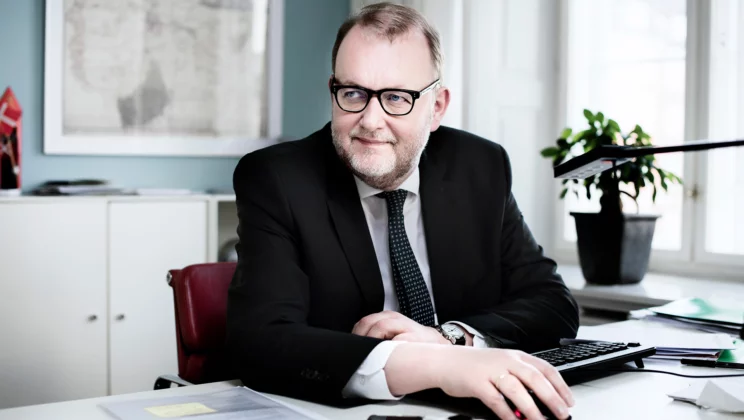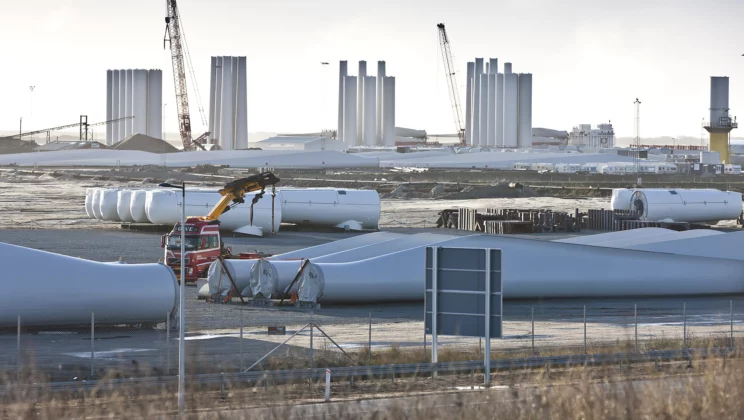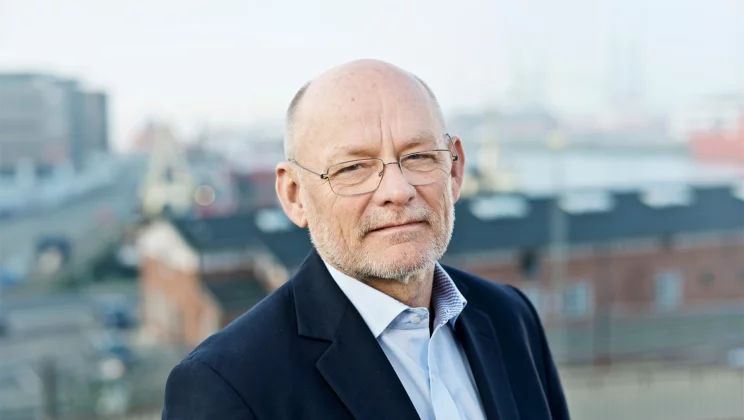The Government will establish the biggest 800 MW wind power park in Denmark's history in the period up to 2024. "All well and good, but more is required up to 2030," is the response from the Port of Esbjerg. International experts are voicing their backing and new export opportunities are emerging.
In 2017, Denmark set the world record with 43.4% of Danish electricity being produced by wind turbines alone. This also means that Denmark is the country in the world that can cover the lion's share of its electricity production with power from wind turbines. At the same time, Denmark is the European country that exports most energy technology.
Therefore, the Government's new energy initiative has also been long-awaited. New goals are needed for how Denmark should maintain and consolidate its leading position. The Minister for Energy, Supply and Climate, Lars Christian Lilleholt says to News Brief:
"Our ambition is for Denmark to be a globally leading wind power nation, also in the future. That is why we are proposing a range of offshore wind farms of up to 800 MW – the biggest in Denmark's history. It should provide a substantial contribution to Denmark's share of renewable energy in 2030," he says and elaborates:
"In other words, offshore wind power is playing a very central role in fulfilling our ambition for at least 50% of Denmark's energy needs to come from renewable energy by 2030."

Offshore wind plays a central role if Denmark is to meet the 50 percent renewable energy target in 2030, says Lars Chr. Lilleholt, Minister for Energy, Supply and Climate. Photo: Jeppe B. Nielsen
Need for certainty
If you ask Ole Ingrisch, Port Director at the Port of Esbjerg, the plans for the new park are good news. But far from enough:
"I think we should have even greater ambitions and a much larger pipeline up to 2030. There is too much wait and see about it. In my view, we should have a framework along the lines of 3 GW up to 2030, spread over three or four parks," he says, explaining that he senses uncertainty among the companies at the port.
"The industry is always pondering where the next investment should be made. If Esbjerg is to maintain investments from the major turbine manufacturers, there must be a clear Danish pipeline. The uncertainty that currently exists could result in us losing potential jobs," says Ole Ingrisch.
Lars Christian Lilleholt acknowledges the criticism but emphasises that the Government has plans for more offshore wind power. However, decisions concerning additional specific parks will not be made until 2022.
"I understand the eagerness for more offshore wind power, but we must beware of the policy of oversupply. We must deliver on our goal of 50% renewable energy in 2030 as cost-effectively as possible. And we must therefore strike a balance between the amount of renewable energy we want and the expense it entails," he says.
Screening for sites
The Government has announced that it will screen Danish waters for sites corresponding to a total of 10 GW in order to identify possible sites for more offshore wind turbines.
"The screening is an essential cornerstone in relation to forward-looking decisions. It will provide the basis for selecting one or more locations for additional offshore wind power up to 2030," says Minister Lars Christian Lilleholt.
Denmark currently has a total capacity of 1271 MW coming from offshore wind turbines, and when Horns Rev 3 and Kriegers Flak are ready for commissioning in 2020, 1000 MW more will be added. In addition, 350 MW of coastal wind farms as well as 50 MW of experimental turbines will be connected in 2020.
At European level, 2017 was a new record year for the wind turbine industry, which installed 3,148 MW of new turbines. And, generally there is momentum right now, according to Tom Remy, an analyst at the European interest group Wind Europe. Many large projects are being completed these years – also in Denmark, where Horns Rev 3 and Kriegers Flak are under construction.
Yet he recognises Ole Ingrisch's call for a clear pipeline all the way up to 2030.
"The biggest barrier for more European offshore wind power is the lack of clear goals and plans from European governments. We still have only a few indications of what should happen after 2022, and this is worrying," he says, but without specifically addressing the new Danish plans.

Wind turbines ready for shipment from Esbjerg. The port of Esbjerg accounts for the most shipments of wind turbines in the world.
Opportunities in the North Sea
Of the 3,148 MW of wind turbines installed in 2017, 2,105 MW was built in the North Sea, which today accounts for 71% of all the electricity from offshore wind power produced in Europe.
"The North Sea is the primary bastion of wind power in Europe, and nothing suggests that will change," says Tom Remy on the prospects for the North Sea.
In Esbjerg, we therefore hope the Government will look towards Horns Rev when choosing the site for the new park.
"Horns Rev has the best wind regime in Denmark, so here you get the most KW out of your investment because it is windier here," says Ole Ingrisch, emphasising that establishing the new Cobra and Viking cables also speaks in favour of Horns Rev, since they can facilitate exporting the surplus power out of the country.
Freer flow in Germany
Another development also advocates more wind power in the North Sea. At the end of March, the German transmission operator TenneT opened up for more electricity being able to flow through the 1,780 MW cable connecting Jutland and Germany. The announcement came after the European Union Commissioner for Competition Margrethe Vestager requested that the Commission study the barriers to more Danish and Nordic power being exported to Germany via the Jutland-Germany link.
For long periods of time, access to the German market has been limited to less than 20% of the actual potential. At Danish Energy, Executive Vice President, Anders Stouge, highlights the possibilities of a better link:
"In the short term, and if the details fall into place smoothly, this would appear to involve a significant increase in access to the Jutland-Germany transmission link. All else being equal, this means a better framework for exporting power south from Denmark to Germany," he says.
TenneT has proposed increasing the available capacity to 1300 MW within six months, and the obligation of 1300 MW is proposed to be in effect for 9 years. By comparison, TenneT allowed access for an average of only about 250 MW in 2015.
A new electricity highway to open running from the Nordic electricity market to Germany bodes well, according to Anders Stouge.
"It will make it more attractive to invest in new renewable energy, since the market that can receive the green power will be significantly larger. This entails growth and green transition, and there is therefore no time to lose."
Wind power on market conditions
The minister will comment on the possible locations for the new park. At the same time, he points out that the Government has not yet committed itself to whether there should be a so-called single-site tender for only one site, or whether multiple sites should be offered simultaneously via a so-called multi-site tender. It will depend on more detailed analyses.
"As a starting point, we would like the most competition regarding the tender. If a multi-site tender can increase the competition, then we would welcome that," the minister says.
If you ask Ole Ingrisch, the industry is more than ready.
"An awful lot has happened in the industry since the first Danish parks were built. The processes have been optimised and the technology is newer. Therefore, 1MW does not require the working hours it once did. We are better and more skilled now and therefore the industry is crying out for larger orders right now," he says.
At the same time, these years Denmark is experiencing that more foreign companies such as Facebook and Google are deciding to build data centres in Denmark, west of Copenhagen. This is good news, according to Ole Ingrisch, but also a sign that Denmark should get up to speed and keep up.
"If the green transition is to make sense, naturally, we must match the development in demand with green power. The fact is that much more green energy is required so that we can continue phasing out coal. That's why politicians should support the wind industry," he says and elaborates:
"And here I'm not talking about subsidies, of course, because wind power must be competitive. But a clear and distinct pipeline would help tremendously."

Ole Ingrisch calls for a clear pipeline for offshore wind up to 2030.
Denmark pioneering the North Sea Alliance
National plans and goals are one thing. International cooperation is another. Here, Tom Remy from Wind Europe points out that the North Sea Alliance is good news for offshore wind power. The development calls for international cooperation on common standards for new projects.
On 10 June 2018, Denmark will take over the presidency of the alliance, which consists of the ten countries around the North Sea.
Lars Christian Lilleholt intends the presidency to focus on harmonising the rules for the production and the setting up of offshore wind turbines, as well as coordination of offshore wind turbine supply.
"We should reduce the costs of offshore wind power and enable the North Sea to be a green power plant for the whole of Europe," he says.
In Esbjerg, they also have high hopes for the presidency – and collaboration in general.
"International collaboration is required because it is no use individual countries developing policies for themselves without thinking of joint solutions," says Ole Ingrisch. Some of what particularly intrigues him is the cooperation on new cables between the countries, standardisation as well as the vision of an energy island at Dogger Bank.
"I would urge that we step up the collaboration so that the North Sea can be a dynamo for the green transition throughout Europe," he says.
Go to overview

